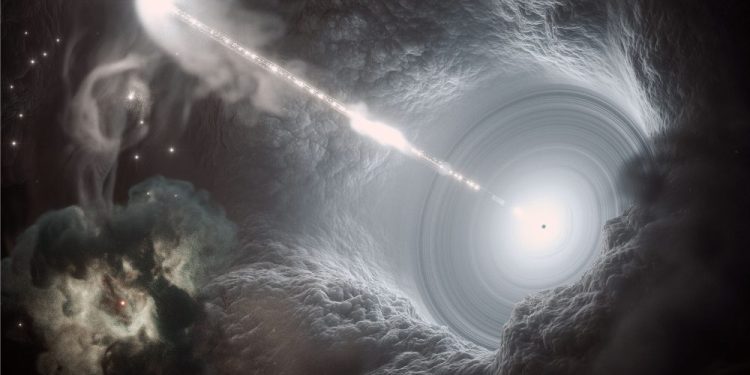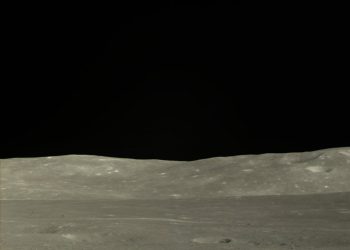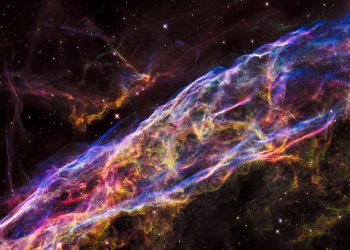A new theory proposes that primordial black holes – black holes that formed at the beginning of our universe – could account for the sought-after dark matter and, strangely, contain tiny collapsed universes within them.
While the new theory is surely a strange idea, the universe we live in is anything short of strange. As revealed by Motherboard, the refreshing theory tackles several of the cosmos’ most important mysteries at once, albeit in a speculative way.
The new study, published in the journal Physical Review Letters, is different from previous theories since it suggests that our entire universe could look like a black hole bubble to an outside observer–from another universe.
Understanding dark matter
Scientists have long struggled to understand and identify dark matter– the invisible matter that is theorized to make up most of the mass in the universe and the “stuff” that helps keep groups o galaxies together. Dark matter is essentially one of the most mysterious components of our universe. Several physicists have proposed that this matter is made of particles that have not yet been detected, that it was formed by boiling plasma and that it might not even exist at all.
However, the new study proposes that these primordial black holes (PBHs) could explain the dark matter scientists struggle to understand. This is refreshingly interesting and sounds interesting mostly because, as explained by Alexander Kusenko, an astrophysicist at UCLA, we are far from understanding what dark matter is. Speaking to Motherboard, Kusenko, who led the new study, revealed:
“We still don’t know what dark matter is made of, but since the black holes are known to exist, it is natural to ask whether the dark matter could be composed of black holes that could form before the stars and galaxies formed.”
Therefore, the study of dark matter is one of the most difficult lines of research in cosmology.
Astrophysics mystery
Since its detection at the beginning of the thirties, a lot of effort has been put into characterizing and understanding it. However, still, in the XXI century, it remains a great mystery to astrophysics. Although much progress has been made towards understanding it in recent decades, it is still unknown exactly what its origin is and what molecules it is composed of.
Dark matter is strange; it can be deduced from its gravitational effects, but not through electromagnetic interactions, such as those in ordinary matter. Dark matter has no electrical charge–or so little that we have not yet been able to detect it–, no one has been able to observe it. Despite this, we believe it exists due to its multiple effects on gravity and the movement of galaxies. That alone makes it one of the most interesting subjects of study in cosmology, which is why the recent study is so appealing.
Primordial Black Holes and dark matter
What’s the connection? The so-called Primordial Black Holes would have sprung into existence during the early moments of our universe when it was extremely dense and in a state of constant flux. Within them, Kusenko explains, there could be small universes, devoid of matter, that began and did not form as our own universe rapidly expanded.
This could mean that we could also exist in such a “bubble” that an outside observer could identify as another primordial black hole. Kusenko reveals that although baby universes we considered were devoid of matter, a little extra physics could probably make them look more like our own to an internal observer.
While this certainly is an exciting concept, it will remain in theory until scientists can obtain factual observational data to expand the theory.
To that end, Kusenko’s team is optimistic that their hypothesis could be tested by the Subaru Hyper Suprime-Cam (HSC) atop Mauna Kea in Hawaii or the Legacy Survey of Space and Time (LSST) of the Rubin Observatory in Chile, which is scheduled to start operating in 2022.
Again, new technology will help humankind peer deeper into the universe than ever before, helping us solve, among other mysteries, the deal with dark matter.
However, the journey toward proving the theory will be a long one. Unfortunately, we cannot detect arbitrarily small mass black holes, and if primordial black holes form dark matter, most of those black holes would go unnoticed, revealed Kusenko.
If black holes formed in the early universe in a variety of sizes, we can probably detect them by the tail of their distribution” In other words, looking for larger PBHs can help scientists make inferences about their smaller counterparts. PBHs can also collide with neutron stars, so scientists may detect primordial black holes as they destroy the neutron star.
Sources, references, and further reading material: Futurism, Vice (Motherboard), Physical Review Letters
Join the discussion and participate in awesome giveaways in our mobile Telegram group. Join Curiosmos on Telegram Today. t.me/Curiosmos











